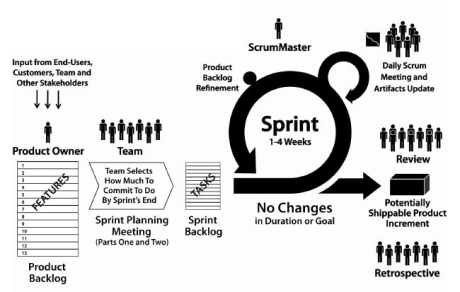Welcome, this blog will briefly introduce you to scrum and also helps you to prepare for Certified Scrum Master (CSM) assessment. This blog compiles info from various blogs & the Scrum Handbook.
What is Agile?
Software development inevitably involves learning, innovation, delivery and surprises. Agile aims to minimize last minute surprises in delivery. It uses iterative and incremental approach to develop a software. It promotes adaptive planning, evolutionary development and delivery, collobarative work, self organized teams and welcomes change in requirements.
What’s Wrong With Traditional Software Development?
Traditional approach has strengths and weaknesses. Its great strength is that it is supremely logical – think before you build, write it all down, follow a plan, and keep everything as organized as possible. It has just one great weakness: humans are involved. Hence a lot of problems occur.
Agile principles?
1. Measure the progress through Working software instead of documentation done up front.
2. Do colloborative work & empower cross functional team to make decisions.
What is SCRUM?
SCRUM is not acronym, it is an agile method i.e. it is based on iterative & incremental approach to develop a software. Each iteration/sprint is timeboxed, usually 2 to 4 weeks. A major theme in Scrum is “inspect and adapt”.
In Scrum, there are three primary roles: The Product Owner, The Team and The Scrum Master. The key artifacts of scrum are product backlog, spring backlog, and burndown chart. It involes short meetings like sprint planning, daily standup meeting, sprint review and retrospective.
 |
| SCRUM FRAMEWORK |
Benefits of SCRUM?
Properly implemented, Scrum will:
- increase of speed of development
- Support shareholder value creation
- Achieve stable and consistent communication of performance at all levels
SCRUM Roles:
The Product Owner is responsible for maximizing return on investment (ROI) by identifying product features, translating these into a prioritized feature list, deciding which should be at the top of the list for the next Sprint, and continually reprioritizing and refining the list.
The Team builds the product that the customer is going to use: the application or website, for example. The team in Scrum is cross-functional and includes all the expertise necessary to deliver the potentially shippable product each Sprint. It is also self-organizing (self-managing), with a very high degree of autonomy and accountability. The Team in Scrum is seven plus or minus two people. Stable Teams are associated with higher productivity, so changing team members should also be avoided.
SCRUM Keywords:
Sprint items are estimated using Story Points. The points completed per Sprint is called the velocity of the team. A realeastic release plan is always based on the velocity of the team.
Definition of Done means coded to standards, reviewed, implemented with unit test-driven development (TDD), tested with 100 percent test automation, integrated, and documented. The implemented feature should meet all the agreed acceptance criterias.
Information Radiator:
Product Backlog Grooming: includes
- detailed requirements analysis
- splitting large items into smaller ones
- estimation of new items
- and re-estimation of existing items
After the Sprint ends, there is the Sprint Review,It is simply a demo of what has been built. Present at this meeting are the Product Owner, Team members, and ScrumMaster, plus customers, stakeholders, experts, executives, and anyone else interested.
The Sprint Review is an inspect and adapt activity for the product.
Sprint Retrospective:
It’s an opportunity for the entire ScrumTeam to discuss what’s working and what’s not working, and agree on changes to try.
“Scrum is hard, but it sure is a whole lot better than what we were doing before!”
Sprint Retrospective:
It’s an opportunity for the entire ScrumTeam to discuss what’s working and what’s not working, and agree on changes to try.
“Scrum is hard, but it sure is a whole lot better than what we were doing before!”

No comments:
Post a Comment